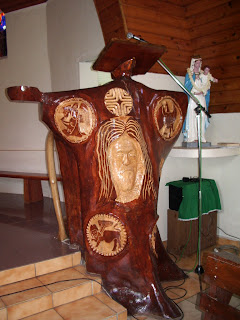I don't have a "home town." I was born in Van Nuys, California (a fifth generation Californian), but lived there for less than a year when my parents took me on the first of many moves throughout my childhood. My dad put a list of all of the addresses we lived in throughout my childhood in the front of my baby book (hidden in a box of memorabilia at the moment), but I can summon up many of the locations. Van Nuys was followed by student housing at UCLA as my dad finished his M.A. in geology.
Dad's career as a petroleum geologist led us around the western United States. By the time I started kindergarten, I had already lived in Vernal, Utah and Casper, Wyoming. Kindergarten and first grade were in Ojai, California. Second grade through the first half of fifth grade were in Lakewood, CA, while the second half of fifth grade and the first half of sixth grade were in Farmington, New Mexico. (Shell Oil Company did not plan their employees' transfers to coincide with the school year.) The second half of sixth grade and the first half of seventh grade were spent back in California - this time in Long Beach. And the second half of seventh grade found me standing self-consciously in the quad of Jane Long Junior High School in Houston, Texas. I finished junior high in Houston, then we returned to California one more time where I actually got to attend the remainder of high school right here at Foothill High School in Bakersfield.
All of our moves really didn't bother me. In fact, when I got to Foothill High, I met girls who had known each other since kindergarten, and I was genuinely shocked. I didn't realize until that moment that people actually grew up in one town. Most of my parents' friends were also oil company folks, and we all moved frequently. As far as I was concerned, home was wherever my family was. Mom and Dad and my sister, Barbara, and brother, Rob, were the constants in my life. In fact, all that moving around gave me a wanderlust, and, I hope, the ability to make friends quickly and to adapt to new situations pretty easily.
Life was always an adventure. My parents didn't have the money to take us on exotic trips overseas, but we explored every new landscape with eager eyes. We called these little adventures "Family Outings." On our nature walks, Dad introduced us to the basics of geology as we explored the canyons and cliff dwellings of the American southwest. We squealed at the sight of dozens of crabs trying to escape from a big tub in the back of our old station wagon after a day of crabbing in Galveston, Texas. Our explorations of the tidepools on the rocky cliffs of the Monterey coast instilled a love of the seaside and marine biology that is still with me today.

And that love of the sea leads me back to Pacific Grove. My dear Grandpa bought the little cottage almost on a whim. We had family roots in Pacific Grove back to the late 1800's when it was a Methodist church summer camp, so my grandparents frequently visited relatives and friends there. One fateful day, my grandmother, Nanda, was enjoying a card game with her best friend and was not finished when Grandpa came to pick her up for their trip back to their home in San Jose. He went out for a walk and found a little home for sale right across the street from Lovers Point beach. By the time they left for San Jose, he had bought the house - and often said that it was the best decision he ever made. My family used the cottage as a vacation home through my high school years. It was a weekend retreat for me and my friends during college years, I took my own children there for many vacations. When my grandparents passed away, my mom and dad added a second story and made this house their permanent home, which makes it even more special to me. It is the home of my heart and, as much as I love traveling the world, I am always happiest when making the drive to Pacific Grove.


























